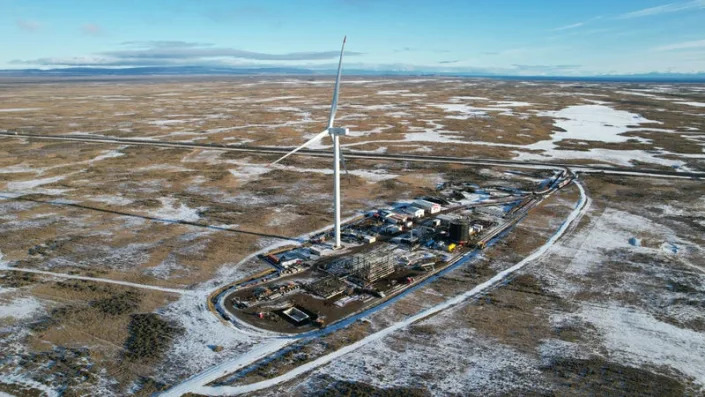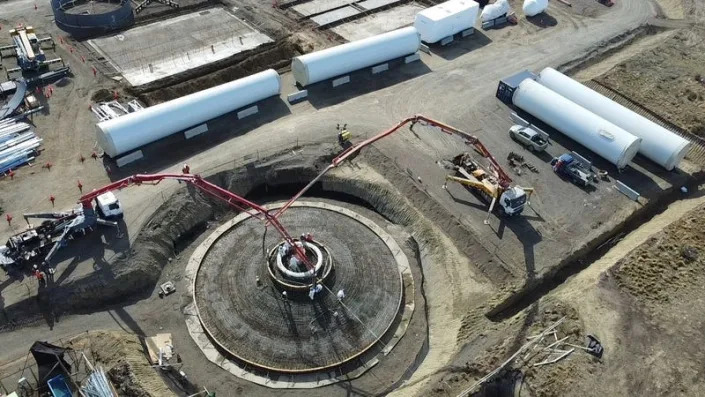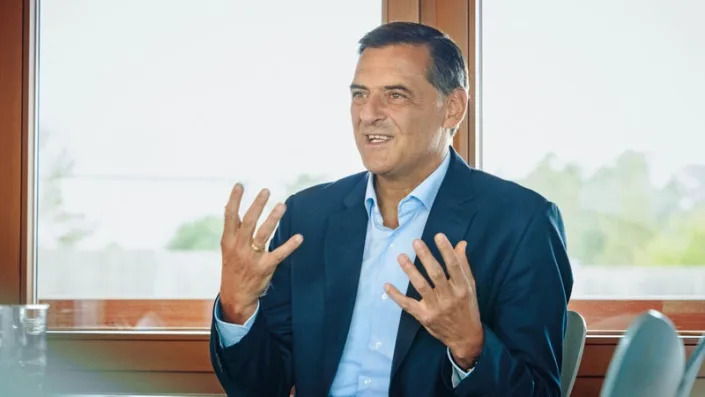FAKE FUEL
Porsche's Plan to Produce (Nearly) Carbon-Neutral Gasoline in Texas
Jim Motavalli
Tue, February 21, 2023

HIF Global’s plant producing synthetic gasoline in southern Chile. Construction on a U.S. e-fuel plant in Texas will begin next year.
Is Porsche on to something? Last June, the German automaker announced that it was investing $75 million and acquiring a 12.5-percent stake in HIF Global LLC, a Chilean company that is producing what’s called “e-fuel,” sustainably-produced gasoline and other conventional fuels produced unconventionally—using hydrogen produced via wind power and captured carbon dioxide (CO2). Fossil fuels for transportation appear doomed globally because of their major contribution to climate change, but HIF thinks it can produce viable replicas in a process that is “nearly” carbon neutral. When burned, e-fuels will still produce tailpipe emissions, of course.
HIF’s first plant, in partnership with ExxonMobil (which is providing its methanol-to-gasoline technology) and Siemens as well as Porsche, is in Chile. But it plans to expand in a big way into the U.S., with as many as a dozen locations.
Michael Steiner, a member of Porsche’s executive board for research and development, said in conjunction with the announcement, “We see ourselves as pioneers in e-fuels and want to drive the technology. This is one building block in our clear, overall sustainability strategy.”
One reason European companies are taking a keen interest in e-fuels is that they’re under study by the European Parliament as a possible loophole in the law banning sale of new internal-combustion vehicles by 2035. Manufacturers are being asked to demonstrate e-fuel’s feasibility by 2026. For that reason, e-fuel has a higher profile in Europe now than it does in the U.S., though that could change. The European law, which exempts fossil fuels in heavy trucks and buses, was finalized in mid-February.
The company’s pilot plant, Haru Oni, in Punta Arenas, Chile officially opened last December with the “ceremonial fueling” of a Porsche 911. The hydrogen is produced via electrolysis of water; a 3.4-megawatt Siemens Gamesa wind turbine co-located with the plant powers the process. Future upgrades will add a lot more wind power.

The location in southernmost Chile makes sense because the wind blows there 270 days a year. In the pilot phase, HIF plans to produce approximately 34,000 gallons of its e-gasoline and send it to Porsche for use in motorsports events such as the Porsche Mobil 1 Supercup, as well as at the company’s experience centers. But by the middle of the decade HIF says the plant will be capable of producing 14.5 million gallons of fuel annually. Two years later, the company says the plant will be up to its full capacity—145.3 million gallons of gasoline and methanol.
But Chile is just the start. HIF is also building a plant in Australia, in northwest Tasmania, producing enough fuel annually to decarbonize five million vehicles. And there’s a third one in Texas. Yes, Texas. The state may harbor some suspicion about fossil-fuel bans, but it is also home to one of the country’s best wind resources—the state’s High Plains region alone has more than 11,000 wind turbines.
The $6 billion plant will be built by the Houston-based U.S. arm of HIF near Bay City, Texas. The Peyton Creek Wind Farm, a huge 151-megawatt facility, opened in Matagorda County (where Bay City is located) in 2020. Bechtel is working on front-end engineering and design of the HIF plant, with construction to begin in the first quarter of 2024.

The HIF Global plant in Chile under construction.
HIF says the Texas plant will produce its first e-fuel in 2027, initially 14,000 barrels per day, or 200 million gallons annually. It plans to make synthetic e-methanol, e-gasoline and e-liquified petroleum gas. Asked how the fuel will be used, HIF said, “The products can be sold anywhere in the U.S. and are considered ‘drop-in’ fuels because they can be used by existing infrastructure and engines. They have the highest value in places that also have economic rewards for low-carbon alternatives.”
HIF says the best such carbon market is in California, which like Europe has 2035 as a fossil fuel deadline for new cars. New York, New Jersey, Washington State and Massachusetts are following California’s lead, and other states are taking parts of California’s plans. In a statement to Jalopnik, HIF said its e-gasoline could keep the huge number of internal-combustion cars in those states running on near-carbon-neutral fuel after 2035. In a statement, the company said, “California’s prohibition on internal-combustion vehicles is on sale of new vehicles. E-fuels can be used by existing vehicles until they reach the end of their useful life, thereby providing a decarbonization pathway for existing infrastructure, a complement to electrification of new infrastructure.”
Porsche agrees with this. In a statement sent by research and development spokesperson Hermann-Josef Stappen, Porsche said, “There will remain a high demand for CO2-reduced fuels for the existing car fleet well beyond 2030. Besides in the existing car fleet, e-fuels can also be used in other transportation sectors such as aviation, shipping, trucks, heavy duty and construction machinery to reduce carbon emissions. Therefore, we see a huge potential for the use of e-fuels.”

Porsche’s Michael Steiner: “We see ourselves as pioneers in e-fuels.”
California has a Low Carbon Fuel Standard (LCFS), “designed to decrease the carbon intensity of California’s transportation fuel pool and provide an increasing range of low-carbon and renewable alternatives, which reduce petroleum dependency and achieve air quality benefits.”
The LCFS offers credits for EV adoption, alternative jet fuel, carbon capture and sequestration, and “advanced technologies to achieve deep decarbonization in the transportation sector.” Does HIF’s products fit into this? It appears likely.
California Air Resources Board spokesman Dave Clegern told Jalopnik, “New fuels can apply to the program and do not require an amendment. Fuel producers must apply to the program and meet LCFS requirements, including delivering that fuel to California as a transportation fuel. For all types of fuel, staff must assess the fuel production pathway to understand the inputs and outputs to ensure accurate lifecycle assessment and carbon-intensity evaluation. New fuels can take longer to evaluate than fuels where we have established pathways.”
The biggest hurdle to widespread adoption of this fuel is its cost. It’s not surprising that Porsche is limiting use of the fuel in the initial stages, because it’s initially going to cost something like $44 a gallon. Scaling up production will reduce that—the parties hope—to something like $7.50 a gallon by mid-decade. That’s still hugely expensive, of course.
The supportive Germany-based eFuel Alliance is relatively optimistic. Ralf Diemer, managing director of the Alliance, told Jalopnik, “We will see plenty of large industrialized [e-fuel] production sites in the U.S. Therefore, I am pretty confident that in 2035 we will have reached competitive prices with fossil fuels. Maybe even in 2030.”
The International Council on Clean Transportation (ICCT) thinks that, even at scale, e-fuel will cost $9 per gallon in the U.S., and $12 a gallon in Europe. “We hope the road sector will be fully electrified—hopefully by 2035 for passenger vehicles and 2040 for heavy duty vehicles—and at that time it will only make sense to use e-fuels in aviation, and maybe maritime,” said Stephanie Searle, program director for fuels and the U.S. at ICCT. “It seems unlikely that the dwindling internal-combustion fleet beyond 2035 will be running on 100 percent e-fuels, given how expensive they are.”
The second U.S. HIF plant, with a location as-yet unannounced, will be designed to produce e-jet fuel. “We will know our cost better after we complete engineering,” the company said. Ultimately, HIF wants to build 12 e-fuel plants in the U.S.
Searle also said that the Environmental Protection Agency is taking comment on the possibility of expanding the Renewable Fuel Standard (RFS) to include e-fuels produced from electricity such as wind and solar if the CO2 used is captured from biomass combustion. By law, the RFS can only include biomass-based fuels.
Jalopnik

No comments:
Post a Comment